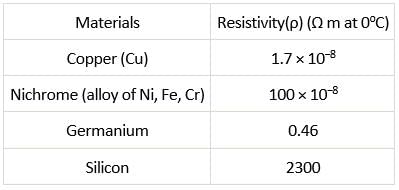NEET Exam > NEET Tests > NCERTs at Fingertips: Textbooks, Tests & Solutions > Test: Resistivity of Various Materials (NCERT) - NEET MCQ
Test: Resistivity of Various Materials (NCERT) - NEET MCQ
Test Description
5 Questions MCQ Test NCERTs at Fingertips: Textbooks, Tests & Solutions - Test: Resistivity of Various Materials (NCERT)
Test: Resistivity of Various Materials (NCERT) for NEET 2025 is part of NCERTs at Fingertips: Textbooks, Tests & Solutions preparation. The Test: Resistivity of Various Materials (NCERT) questions and answers have been
prepared according to the NEET exam syllabus.The Test: Resistivity of Various Materials (NCERT) MCQs are made for NEET 2025 Exam. Find important
definitions, questions, notes, meanings, examples, exercises, MCQs and online tests for Test: Resistivity of Various Materials (NCERT) below.
Solutions of Test: Resistivity of Various Materials (NCERT) questions in English are available as part of our NCERTs at Fingertips: Textbooks, Tests & Solutions for NEET & Test: Resistivity of Various Materials (NCERT) solutions in
Hindi for NCERTs at Fingertips: Textbooks, Tests & Solutions course. Download more important topics, notes, lectures and mock
test series for NEET Exam by signing up for free. Attempt Test: Resistivity of Various Materials (NCERT) | 5 questions in 5 minutes | Mock test for NEET preparation | Free important questions MCQ to study NCERTs at Fingertips: Textbooks, Tests & Solutions for NEET Exam | Download free PDF with solutions
Detailed Solution for Test: Resistivity of Various Materials (NCERT) - Question 1
Detailed Solution for Test: Resistivity of Various Materials (NCERT) - Question 2
Test: Resistivity of Various Materials (NCERT) - Question 3
The resistivity of alloy manganin is
Detailed Solution for Test: Resistivity of Various Materials (NCERT) - Question 3
Test: Resistivity of Various Materials (NCERT) - Question 4
Arrange the following materials in increasing order of their resistivity,
Nichrome, Copper, Germanium, Silicon
Detailed Solution for Test: Resistivity of Various Materials (NCERT) - Question 4
Test: Resistivity of Various Materials (NCERT) - Question 5
What is the order of magnitude of the resistance of a dry human body?
Detailed Solution for Test: Resistivity of Various Materials (NCERT) - Question 5
|
257 docs|234 tests
|
Information about Test: Resistivity of Various Materials (NCERT) Page
In this test you can find the Exam questions for Test: Resistivity of Various Materials (NCERT) solved & explained in the simplest way possible.
Besides giving Questions and answers for Test: Resistivity of Various Materials (NCERT), EduRev gives you an ample number of Online tests for practice





















